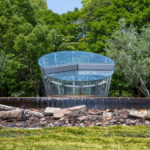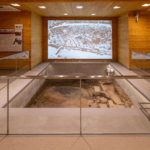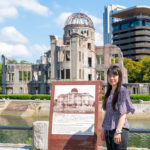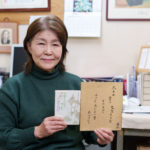II The Atomic Bombing
1 Lead up to the Atomic Bombing
The development of atomic bombs by the U.S. and the U.K. began with the pleas of scientists who feared that Nazi Germany may have already been in possession of one. The president of the United States, Franklin D. Roosevelt, was informed that an atomic bomb could actually be built at talks in England and secretly began development plans for such a weapon in June 1942. In April 1943, the Los Alamos National Laboratory was set up in New Mexico, and a large number of scientists and engineers were mobilized to work with two billion dollars of funding on this enormous project. In September 1944, at a meeting between the leaders of the U.S. and the U.K., it was agreed that the atomic bomb would be used on Japan after due consideration, upon its completion. A unit to carry out the bombing (the 509th Composite Group) was formed and conducted top secret training for the bombing. On July 16, 1945, the first atomic bomb test in the world was carried out in the desert of Alamogordo, New Mexico.
In May 1945, four cities, including Hiroshima and Kyoto, were chosen as potential targets for the first two atomic bombs. The bombs were scheduled to be dropped in early August. The targets were changed a number of times after that and air raids on these cities were forbidden. This was because the United States wanted to demonstrate the full potential of the atomic bomb.
Scientists petitioned against using the atomic bomb and even some senior military officials believed that its use was not necessary. However, the United States decided to use the bomb, despite the ethical concerns, in order to secure supremacy in the postwar world and gain supremacy over the Soviet Union, which was planning to enter the war against Japan, and to justify the astronomical amount of money and resources that had gone into the development of the weapon, among other reasons.
On July 25, President Harry S. Truman approved orders for the atomic bombing to
move forward. At this time, either Hiroshima, Kokura, Niigata, or Nagasaki was to be bombed on a date around or after August 3. On July 26, the Potsdam Declaration, which demanded that Japan agree to an unconditional surrender, was issued. If the Japanese government had quickly accepted these terms, the atomic bombing could have been avoided. In other words, if the United States had already made the decision to use the atomic bomb in war, there was a need to hurry. The Soviet Union’s entry into the war against Japan was closing in. In that case, Japan would lose any hope for making peace and may have surrendered shortly after.
On August 2, the decision to use the atomic bomb on August 6 was reached. The first target was Hiroshima. (The target was to have been near the Aioi Bridge.) Kokura and Nagasaki were back-up targets. On August 6, a uranium-type atomic bomb, nicknamed “Little Boy,” was dropped on the city of Hiroshima. Not long afterwards, on August 9, a plutonium-type atomic bomb, nicknamed “Fat Man,” was dropped on the city of Nagasaki. On August 14, the Japanese government accepted the Potsdam Declaration, and on the next day, August 15, the Showa Emperor read an imperial edict ending the war and it was broadcasted over the radio. A third atomic bomb was being readied and training for the dropping of this bomb was being carried out until the day before Japan surrendered.
2 The Power of the Atomic Bomb and Its Damage
At 8:15 a.m. on August 6, the atomic bomb was dropped from the Enola Gay, a B-29 bomber that had taken off from Tinian Island. It fell towards its target, the Aioi Bridge. Approximately forty-three seconds after the bomb was released, it exploded mid-air in a nuclear eruption approximately 600 meters above the Shima Hospital, slightly southeast of the Aioi Bridge. A large number of neutrons were emitted through the process of nuclear fission. In the moment it exploded and a gigantic fireball appeared, intense heat rays were emitted, causing the ground temperature of the surrounding area reach to temperatures between 3000 to 4000 degrees centigrade. After the initial fireball, a mushroom cloud (atomic cloud) of approximately 16,000 meters in height formed. Also, the intensive bomb blast created maximum wind speeds of 440 meters per second at the hypocenter. The blast spread out radially, and swept the entire city in about 10 seconds.
Although the heat rays were only emitted for a short period of time, their extreme intensity caused anyone within a one-kilometer radius from the hypocenter to receive multiple severe burns. Even people over three kilometers away from the hypocenter were burned on the parts of their bodies that were not covered by clothing. Many were blown off of their feet by the blast and resulting in many deaths, injuries, or people losing consciousness. Wooden structures located within two kilometers of the hypocenter were completely destroyed, and there were people left trapped under the remains. Shortly after, fires broke out spontaneously from the heat rays, and the fires that started among the ruined buildings spread. Thirty minutes after the explosion, Hiroshima was covered in a disastrous firestorm. Anything flammable located within a two-kilometer radius of the hypocenter was engulfed in flames, and many people were burned to death. Radioactive waves emitted from the explosion caused severe damage to the human body. At a distance of one kilometer from the hypocenter, neutrons and gamma rays gave off four grays of radiation, estimated to be enough radiation to cause death of one out of two people. One after another, people showing no external injuries became sick after a couple of days and later died. People who were not directly exposed to the atomic bombing were also exposed to radiation. This included those who lived on the outskirts of town, where people were not directly exposed to the bombing but radioactive black rain fell, and those who were exposed to residual radiation upon entering the city.
It is unknown exactly how many people died from the atomic bombing. On November 30, 1945, the Hiroshima Prefectural Police placed the number of dead at 78,150 and the number of missing at 13,983. They calculated these numbers after counting the victims one by one, excluding members of the military from the count. As for the military dead, a complete survey was taken of documents from all branches of the military, and in November 1947, the results showed that there were 9,242 deaths and 889 people whose lives were unaccounted for. In contrast, various estimates have been carried out to find the actual number of deaths. The resources that the City of Hiroshima handed over to the United Nations in 1976 estimated the number of deaths to have been 140,000 ± 10,000 at the end of 1945. In recent years, the “Statistical Survey of Atomic Bomb Victims” has been underway. This survey integrated various types of information related to atomic bomb victims on computers and used the results to make identifications. In one recent survey, the total number of victims was 557,478, including 384,743 who were directly exposed to the atomic bomb, and 118,861 who were exposed to residual radiation after entering the city, and others who were exposed by other means. Included in these figures are 53,644 people who died on August 6, and another 35,334 who had died by the end of 1945 (a total of 88,978 people). 3)
3 The Rescue System and Mobilization
The blast of the atomic bomb caused far more damage than anyone could have imagined and the previous air raid preparations proved insufficient. The Prefectural Government Office was completely destroyed. Pre-designated provisional locations in the event of air raid disaster, such as City Hall, Honkawa National School, the Commerce, Industry and Economy Association Building, Aki Girls’ High School, and Fukuya Department Store, were also eradicated or collapsed. The Prefectural Government, which was supposed to take command after an air raid disaster, temporarily ceased all functions, and the air defense headquarters of the prefecture had not been set up until nearly nine hours after the bombing. The governor of the Prefecture was away on business at the time of the bombing, so the chief of the prefectural police set up the headquarters at Tamon-in Temple at Hijiyama in his stead. He ordered each police department in the prefecture, through the police departments of Kabe and Kaitaichi, to provide food, and to send police officers, members of the civil defense units, and members of their relief squads for support, based on predetermined plans. The Army Marine Headquarters in Ujina (nicknamed the Akatsuki Corps) independently engaged in rescue operations almost immediately after the bombing. The Army Marine Headquarters was flooded with burn victims by 8:50 a.m. and the Marine Commander delivered the following address, “Today, August 6, at 8:15 a.m., Hiroshima was bombarded by enemy planes. There are fires throughout the city and there seem to be a large number of casualties as a result of the blast.” Troops were ordered to focus on extinguishing fires in the city and to engage in rescue operations while burn victims were to be transported to the Ninoshima Quarantine Station. Moreover, by 11:30 a.m., all troops were ordered to cease their normal duties and to take part in the rescue operations. While the number of victims quickly increased, four relief stations were set up at 8:40 p.m., including Yokohama National School in Saka Village in Aki County, and 1000 people were transported by sea. 4)
Around 2 p.m. on August 6, the Deputy Governor-General of the Chugoku District visited the Second General Army Headquarters. He reported the death of the Governor-General and the destruction of the Prefectural Government Office, City Hall, and police facilities. He entrusted the army to handle the situation and ordered them to rescue survivors of the disaster. Having been charged with this new mission, the Second General Army appointed the Army Marine Commander, who had already taken charge of rescue operations, as the Hiroshima Defense Commander. In this way spontaneous rescue operations were rapidly unified into one chain of command, under the control of the Army Marine Commander. It was now the decisive time they had prepared for, when battle reached the mainland. Orders were passed down and a large mobilization took place in an effort to conduct rescue operations and bring the situation under control in the midst of unprecedented chaos.
While it was the Ujina marine units that took center stage in the military-run rescue operations, marine units stationed outside the city of Hiroshima were also ordered by the Army Marine Commander to assist in the rescue operations. The number of soldiers of the marine units mobilized from Hiroshima City and the surrounding area reached 4,000. Upon hearing reports from people returning from Hiroshima, the Kure District Headquarters of the Navy ordered rescue units to prepare for dispatch at 11:20 a.m., and at 1:25 p.m., five units were sent to Hiroshima. Units under the direction of the Second General Army also came in in succession to aid in the rescue. Early in the morning on August 7, around 160 soldiers from the Sobu 321st Infantry, stationed in Hara Village (Hachihommatsu) in Kamo County, reached Hiroshima City. The Eba and Hesaka branches of the Hiroshima First Army Hospital began rescue operations shortly after the bombing and all army hospital facilities also conducted their own rescue activities.
Hiroshima City’s preparations for air raids were all but wiped out in the blast but the prefecture-wide rescue system, which was prepared for air raids in Hiroshima City, began functioning right away. By 3 p.m. on the day of the bombing, 120,000 rations of dried bread were distributed. Later that day, a rescue squad from Toyota County arrived at Tamon-in Temple in Hijiyama and a rescue station was set up. On August 7, rescue squads from each police department, numbering 300 people, came to Hiroshima. Also, on the same day, 190 police officers and 2,159 members of civil defense units were deployed in Hiroshima. In total, over 20,000 members of civil defense units were deployed. The Special District Guards, set up in each county of Hiroshima Prefecture, were called together as soon as word was received that Hiroshima had been bombed. The deployment of rescue squads made up of doctors, nurses, and other rescue workers to Hiroshima continued under the War Disaster Protection Law while it was in effect through October 5. The total number of rescue staff deployed to Hiroshima City from all over the prefecture was 2,557 people for a total of 21,145 man-days. The total number of rescue staff deployed from other prefectures rose to 715 people for a cumulative total of 5,397 man-days. Teachers and students from girls’ high schools, and other civilians were also mobilized for rescue support.
Moreover, the military, specifically the Military Police, took great pains to preserve order after the air raids. On August 8, under an order of the Chugoku Military Police Headquarters, warnings against the spread of harmful rumors were issued as follows:
Because the bomb, used in the latest enemy air raid, was much more powerful in force than those used in previous air raids, people are being driven to fear and anxiety and overexaggerating the capacity of this bomb, spreading word that it has caused great destruction and discussing the military’s defensive strategy. It is predicted that should the matter get out of hand people will take a pessimistic view, speaking and behaving as if the war is lost and harmful rumors against the military, against the war, and for peace will spread. It is necessary to thoroughly enforce controls over such rumors.
4 Relief Stations
Hiroshima City had designated 32 locations as first-aid stations, including all National Schools in the city, and 18 other locations as first-aid hospitals. However, due to the devastating force of the atomic bomb, preplanned rescue operations were unable to be carried out. Whether inside of burnt out rubble or on a riverbank, any place where the critically injured were gathered in great numbers was designated as a relief station, and rescue squads were sent there to carry out spontaneous rescue operations. However, nothing could be done for those critically injured or patients who had received large amounts of radiation.
It is unclear exactly how many relief stations were set up. Relying only on information gathered from various references and diaries, it can be estimated that the total number of relief stations set up on August 6 was 99 in the city (16 of which were at hospitals) and 142 outside the city (38 of these were at hospitals); for a total 241 relief stations. 5)
Hospitals that escaped collapse or complete destruction by fire, such as the Hiroshima Red Cross Hospital and the Hiroshima Communications Hospital, began conducting rescue operations immediately after the bombing. Rescue stations were set up at various locations and by August 7, the Army Medical Corps began treating survivors at the Honkawa National School. From August 8 until September 6, rescue teams from Hiroshima Sanatorium in Saijo Town, Miyoshi, Kake, Onomichi, Mihara, Takehara, and Innoshima gathered at this school to provide assistance.
The number of evacuees and the injured, who fled or were transported out of the city area of Hiroshima, reached well over 200,000. Many fled on foot and some were transported by trains, trucks, or by boats. Many people were provided accommodations in remote locations such as Shobara and Tojo on the Geibi Line, and Otake and Iwakuni to the west of the city. In the surrounding towns and villages, evacuees were sent not only to relief stations and schools, etc., but also to private residences.
5 Disposing of the Dead
In addition to providing aid to the injured, disposing of dead bodies was also a difficult problem. The impact that disposal of the deceased had on the general public was great. It was the summer season of rot, and the disposal needed to be handled respectfully and quickly. Shinto priests and Buddhist monks were made available at onsite cremations and burials as often as was possible. It was impossible to know everyone’s name, but a survey was organized to find out the exact number of victims. An order was also given for the first phase of the disposal of the bodies to be completed by August 9.
General body disposal operations carried out by the military, the police, and the civil defense units ended on August 11, but small scale body disposal operations, collecting bodies from the sea and from the burned ruins still continued. The number of bodies counted by the prefecture by August 20 includes the 17,865 bodies disposed of by the police, 12,054 by the military, and 3,040 other cases where people evacuated to other municipalities and died there. (It means that by this point less than half of all the bodies were disposed of). On site in the city area of Hiroshima, bodies were cremated and the remains were handed over to relatives or to the City of Hiroshima. Remains taken in by the city were handed over to bereaved family members via the Health Section of the Citizens’ Affairs Department. As of October 31, the remains of 11,525 individuals had been received by the city, 4,805 handed over to family members, and 6,720 left unclaimed. 6)
(Fukuhei Ando)
Notes and References
3. City of Hiroshima. Genbaku Hibakusha Dotai Chosa Jigyo Hokokusho (Statistical Survey of Atomic Bomb Victims Project Report).Mar. 2013.
4. Sempaku Shireibu Sakumei Tsuzuri (File of the Marine Headquarters’ Orders). Military Archives, Center for Military History, the National Institute for Defense Studies, Ministry of Defense.
5. Tani, Seiji. “1945 Nen Hachi Gatsu Muika Hiroshima Genbaku Toka Ji no Kyugosho” (Relief Stations on August 6, 1945: the Time of the Atomic Bombing of Hiroshima). http://home.hiroshima-u.ac.jp/heiwa/Pub/42/22Tani.pdf.
6. Showa Niju Nen Hiroshimashi Jimu Hokokusho narabini Zaisanhyo (Outline of Business and List of Properties of the City of Hiroshima,1945).
City of Hiroshima. Shinshu Hiroshima Shishi (History of the City of Hiroshima: New Edition). Mar. 1958 – Feb. 1961. Total in 7 volumes.
City of Hiroshima. Hiroshima Genbaku Sensaishi: Dai Ikkan (Record of the Hiroshima A-bomb War Disaster, Vol.1). Aug. 1971.
Hiroshima Prefecture. Hiroshima Kenshi: Genbaku Shiryo Hen (History of Hiroshima Prefecture: Resource Materials on the Atomic
Bombing). Mar. 1972.
Hiroshima Prefecture. Hiroshima Kenshi: Kindai 2 (History of Hiroshima Prefecture: Modern History 2). Mar. 1981.
Hiroshima Prefecture. Hiroshimaken Sensaishi (History of War Damage in Hiroshima Prefecture). Jun. 1988.
Yoshida, Morio. Kyoto ni Genbaku o Toka Seyo (Drop the Atomic Bomb on Kyoto). Kadokawa Shoten, Jul. 1995.
Hiroshima Peace Memorial Museum. Hiroshima o Sekai ni (Hiroshima to the World). Mar. 1999.
NHK Hiroshima Kaku Heiwa Project. Genbaku Toka, Jyu Byo no Shogeki (The Atomic Bombing: The Fateful Ten Seconds). Nihon Hoso Shuppan Kyokai, Jul. 1999.








